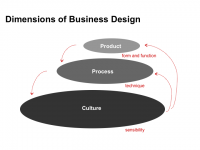Google vs. Yahoo: Clash of Cultures helpfully contrasts the cultures of both companies and how culture influences future performance….
As the two giants tussle for domination of online advertising dollars, it’s increasingly clear that this tug-of-war is really a test of what kind of corporate culture an Internet company needs: Is it a by-the-numbers and increasingly Hollywood-savvy environment like Yahoo’s? Or can an intellectual playground like Google continue to grow and thrive even as it approaches $4 billion in annual revenue?
 It’s hard to agree more with the usefulness of examining the situation through this lens (and express pleasant surprise this sentiment comes from a techie site). An organization’s outward displays of innovation and operations are only symptoms of their health; culture is their heart. My business partner John gave a presentation recently making this point, illustrating the back-and-forth change ripple effect between product, process, and culture: Design [is not a] Strategy (.pdf).
It’s hard to agree more with the usefulness of examining the situation through this lens (and express pleasant surprise this sentiment comes from a techie site). An organization’s outward displays of innovation and operations are only symptoms of their health; culture is their heart. My business partner John gave a presentation recently making this point, illustrating the back-and-forth change ripple effect between product, process, and culture: Design [is not a] Strategy (.pdf).
Comments
4 responses to “How culture influences process and product”
Another cultural comparison piece was in Wired earlier this year.
http://www.wired.com/wired/archive/13.03/yahoo.html
Not to mention from their current issue – an excerpted history of Google – mostly technical but at least gives some insight into the birth of the firm – http://www.wired.com/wired/archive/13.08/battelle.html
Thanks for a great blog!
I’m wondering how to apply these insights in practice: How can I, as a designer, go about changing a culture that does not promote innovation – or even worse, a culture that confuses “innovation posing” with the “innovative stance” described in the “Design [is not a] Strategy” presentation?
(btw, my motivation for doing this is entirely selfish. I want to work on successful products – and if the culture is wrong, the product is likely to fail whether I do my job well or not)
So, what do I do? Join management? Teach managers to think like designers (remember, this took years of practice for the rest of us)? A product manager is usually happy to let a designer create pretty screenshots for his presentations (“posing”), but will he let the same designer tell him how to think?
How do you guys do it?
Max — Thanks for writing, and for the excellent questions. I’ll try to answer them in a future post. But the point of this is *not* to try to directly change how people think, the culture, or the process (unless you can, which is great) but to use product design to do that for you. People are comfortable focusing on products, and if you can start to inject (implicitly) more design thinking into the process, it can gradually change how people think, the process they use, their culture. Yes, it is gradual and takes a long time. We’re starting to find some shortcuts, and I’ll blog about those too.